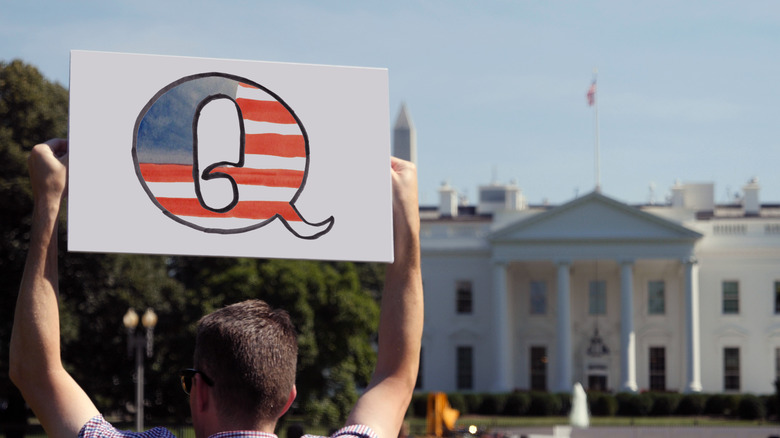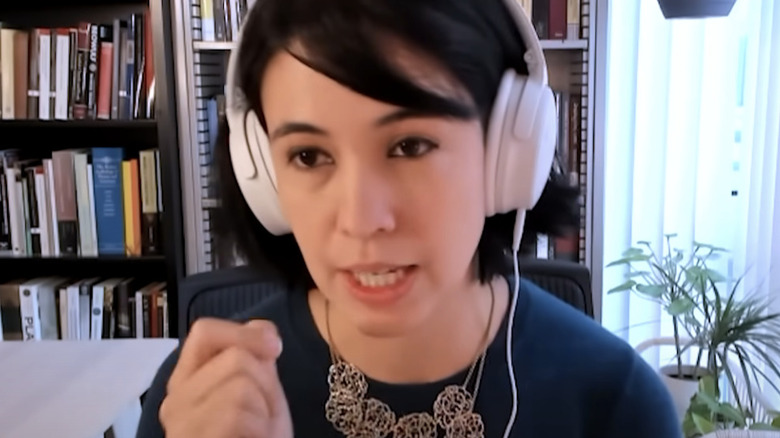Why The Pizzagate Conspiracy Theory Just Won't Seem To Die
These days, it may seem like unfounded conspiracy theories are everywhere, from the impossible-to-believe Birds Aren't Real movement to more menacing (yet no less outlandish) theories like Pizzagate, or the claim that some Hollywood stars and members of the Democratic Party traffic children, as The New York Times explains. Is this proliferation of conspiracy theories, propagated largely by movements like QAnon and through the platforms of talk show hosts like Alex Jones, simply a byproduct of online culture and social media?
Speaking on The Daily Show's "Jordan Klepper Fingers the Conspiracy" podcast, Matt Gertz of the online media watchdog group Media Matters and Professor Elise Wang, a conspiracy theory expert at Duke University, discuss how the speed and ease with which information now travels online — accurate and otherwise — has influenced how quickly these theories seem to spread. Similar theories have existed throughout history, though, and more often than not, those behind these worldviews politically benefit from widespread belief in the conspiracies, however far-fetched they may seem.
Some in medieval times believed in the blood libel conspiracy
According to Professor Elise Wang, what's strikingly similar to the unfounded online conspiracy theory known as Pizzagate — which is still spreading on social platforms like TikTok (per The New York Times) — is the so-called blood libel conspiracy theory, common in medieval times. As the Anti-Defamation League (ADL) explains, the blood libel conspiracy, beginning around the 12th century in England, says that members of the Jewish community kill children and drink their blood for religious rituals such as Passover, an untrue antisemitic notion held by some as recently as 1928 that spread throughout Europe, into the United States, and across some parts of the Middle East.
Some Pizzagate adherents also push the baseless idea that Hollywood elites and certain politicians extract adrenochrome from children, a substance produced naturally in the human adrenal gland, which they then consume like a drug, as WIRED notes. This theory is rooted in the blood libel conspiracy. As Wang goes on to add, perhaps the most famous example of blood libel in medieval times involves Simon of Trent, a young boy who went missing in 15th-century England. Accusing the local Jewish community, the blood libel explanation was motivated by an interest in the economic benefit of sainthood for the child, as well as pushback against the pope, who a local bishop believed had grown too close with the Jewish community.
Blood libel, like Pizzagate, is rooted in antisemitism
As can be seen, blood libel and Pizzagate share more than just misguided concern for the health and well-being of children: Both theories have highly antisemitic connotations, as famous Hollywood individuals and high-ranking members of the Democratic Party are often used in modern conspiracy theory parlance as a passcode for the Jewish community. Per The Atlantic reporting, details differ from one baseless conspiracy theory to another, but similar antisemitic ideas are behind the most pervasive theories today. Also notable, the spread of conspiracy theories such as Pizzagate is rarely organic but instead the byproduct of carefully planned propaganda campaigns.
This was also true in the case of blood libel, as Wang explained. "[I]t wasn't like this was a grassroots rumor that was rooted in sort of general antisemitism," Wang said on Jordan Klepper's podcast, referring to the blood libel theory. Blood libel, she said, "was very intentionally crafted for a political end by someone who was powerful." The theory that Jews killed and used the blood of children in their ceremonies, Wang continued, "spread by word of mouth, but it also spread by these sort of cultural productions," like woodcuts and poems to honor young Simon of Trent. And in modern times, social media platforms have helped similar misinformation spread faster and further than before, as Matt Gertz from Media Matters explains.
Social media helps people find their conspiracy community
On the topic of the role social media has had on the seeming ubiquity of conspiracy theories in our modern media, Matt Gertz went on to add that although social media platforms and online content providers promise to bring the world together or offer "an opportunity to find community," they foster communication with people from across the globe in order "to find a common purpose together, and there's a dark side to that." "It has also made it much, much easier to find a community of conspiracy theorists," Gertz added, "To share your dark ideas about hidden messages in the world's events."
Referring to Pizzagate, Gertz told Jordan Klepper on his podcast, "I think Pizzagate was really a turning point because we saw that someone could use those conspiracy theories, could inflate them, and that there could be a big real-world impact when people who came to believe those conspiracy theories went too far." Klepper podcast aside, Alice Marwick, an expert on conspiracies at the University of North Carolina at Chapel Hill, told The New York Times that Pizzagate has yet to go away because it encompasses very "potent forces" like children's safety and class anxiety. And now that there is so much scaffolding from people who have supposedly done their research, it's easy "for others to pick up from there," Marwick added.
Conspiracy theories help some people feel like heroes
As both Elise Wang and Matt Gertz explain on Jordan Klepper's podcast, one allure of conspiracy thinking is that it makes someone who buys into this kind of worldview feel like a hero, and that doesn't bode well for the deepening partisanship divide in U.S. politics. Conspiracy theories, Wang continues, are fundamentally non-discursive, meaning those who believe in them can rarely engage in conversation or consider an opposing point of view. Conspiracies like Pizzagate, among others, are not about the details or the story — they are instead an attempt to make this "core story about yourself match up with the world, and every conspiracy theory has this same core story," Wang said.
As Wang continues, the story common in almost all conspiracies is that in the past, traditional power structures were intact and everything was safe, but then the monsters took hold, and believers in conspiracies are the only ones who know the truth, making anyone who supports and propagates a conspiracy theory something of an embattled hero. That way of thinking has also reframed our discussion on topics like democracy and fair play. After trust in institutions like legacy media and government bodies break down, hastened by certain conspiracies, "then the only thing you can trust is your own sense of the story that you like," Wang said.




